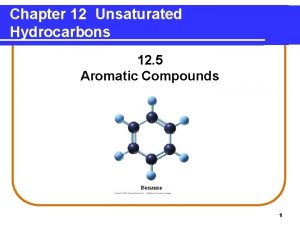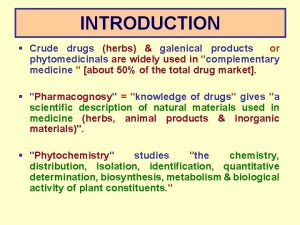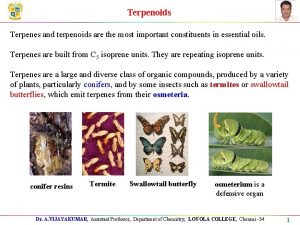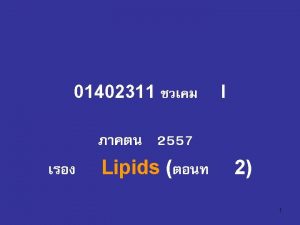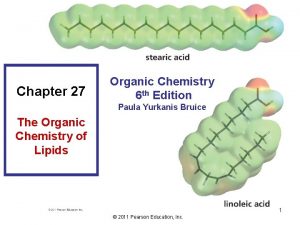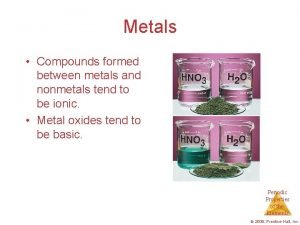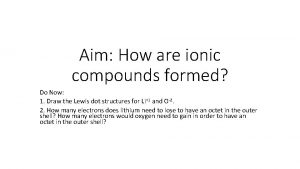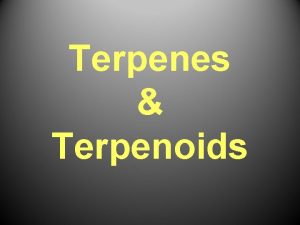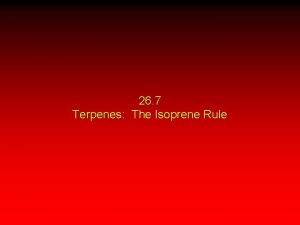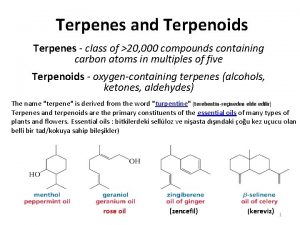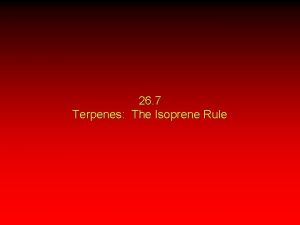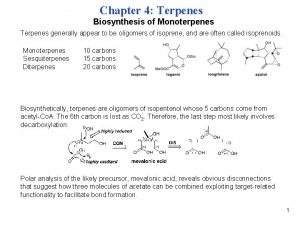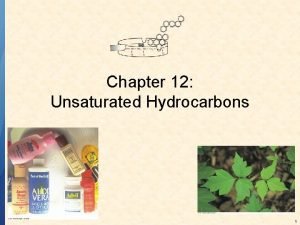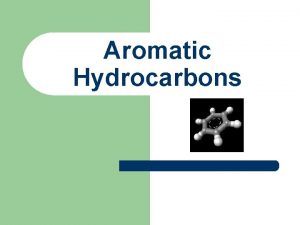Terpenes Learning outcomes Terpenes are unsaturated compounds formed




















- Slides: 20

Terpenes

Learning outcomes ¢ Terpenes are unsaturated compounds formed by joining together isoprene units. ¢ Terpenes are components of a wide variety of fruit and floral flavours and aromas. ¢ Terpene derivatives are responsible for the distinctive aroma of spices.

Terpenes ¢ The name ‘terpene’ is derived from the Greek word ‘terebinth’. ¢ Terebinth is a type of pine tree from which terpene-containing resins are obtained.

What are terpenes? ¢ Natural organic compounds. ¢ Components of a variety of fruit and floral flavours and aromas. ¢ Used in perfumes, essential oils and medicines.

Essential oils contain terpenes ¢ Lavender – used to relieve tension. ¢ Ylang-ylang – used to treat anxiety. ¢ Lemon oil – aids good circulation. ¢ Essential oils often contain a mixture of terpenes.

Spices contain terpenes ¢ Terpenes in plants can be oxidised to produce the compounds responsible for the distinctive aroma of spices. ¢ Terpenes containing oxygen or other functional groups are known as ‘terpenoids’. ¢ Common spices containing terpenes include cloves, cinnamon and ginger.

Terpenes are unsaturated ¢ Terpenes are unsaturated compounds. ¢ All terpenes are built up from units of isoprene.

Isoprene ¢ Isoprene is the common name for 2 -methylbuta-1, 3 -diene

Isoprene One isoprene unit contains five carbon atoms

Building terpenes from isoprene Isoprene units can be linked: ¢ head to tail to form linear terpenes ¢ in rings to form cyclic terpenes.

Myrcene – a linear terpene Head Tail • Myrcene is a component of plants, including bay, ylang-ylang and thyme.

Limonene – a cyclic terpene

Menthol – a cyclic terpenoid This terpene has been oxidised to a terpenoid

Absinthe – a cyclic terpenoid This terpene has been oxidised to a terpenoid

Camphor – a cyclic terpenoid

a-Selinene – a cyclic terpene 3 isoprene units 15 carbon atoms

β-carotene – a linear terpene 8 isoprene units 40 carbon atoms

Questions ¢ Which unit makes up every terpene? ¢ How many carbons are there in an isoprene unit? ¢ What is the systematic name for isoprene? ¢ What is an oxidised terpene known as?

Answers ¢ ¢ Which unit makes up every terpene? Isoprene unit How many carbons there are in an isoprene unit? Five What is the systematic name for isoprene? 2 -methylbuta-1, 3 -diene What is an oxidised terpene known as? Terpenoid

Summary ¢ Terpenes are unsaturated compounds formed by joining together isoprene units. ¢ Terpenes are components in a wide variety of fruit and floral flavours and aromas. ¢ Terpenes can be oxidised within plants to produce the compounds responsible for the distinctive aroma of spices.
 Mikael ferm
Mikael ferm Unsaturated aromatic compounds
Unsaturated aromatic compounds What is an unsaturated hydrocarbon
What is an unsaturated hydrocarbon Guaiol terpene
Guaiol terpene Enfleurage method ppt
Enfleurage method ppt Classification of terpenoids
Classification of terpenoids Terpenes to steroids
Terpenes to steroids Terpenes steroids prostaglandins
Terpenes steroids prostaglandins Compounds formed between metal and nonmetals
Compounds formed between metal and nonmetals How are ionic compounds formed
How are ionic compounds formed Covalent and ionic venn diagram
Covalent and ionic venn diagram Example of learning outcomes
Example of learning outcomes Water cycle learning outcomes
Water cycle learning outcomes Objectives of notice
Objectives of notice Swot analysis objectives
Swot analysis objectives Objectives of rhymes
Objectives of rhymes Example of learning objectives
Example of learning objectives Photolysis in photosynthesis
Photolysis in photosynthesis Learning objectives of photosynthesis
Learning objectives of photosynthesis Domain 6 community linkages explanation
Domain 6 community linkages explanation Learning outcomes of linear equations in one variable
Learning outcomes of linear equations in one variable

